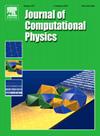Numerical experiments using the barycentric Lagrange treecode to compute correlated random displacements for Brownian dynamics simulations
IF 3.8
2区 物理与天体物理
Q2 COMPUTER SCIENCE, INTERDISCIPLINARY APPLICATIONS
引用次数: 0
Abstract
To account for hydrodynamic interactions among solvated molecules, Brownian dynamics simulations require correlated random displacements , where D is the Rotne-Prager-Yamakawa diffusion tensor for a system of N particles and z is a standard normal random vector. The Spectral Lanczos Decomposition Method (SLDM) computes a sequence of Krylov subspace approximations , but each step requires a dense matrix-vector product with a Lanczos vector q, and the cost of computing the product by direct summation (DS) is an obstacle for large-scale simulations. This work employs the barycentric Lagrange treecode (BLTC) to reduce the cost of the matrix-vector product to while introducing a controllable approximation error. Numerical experiments compare the performance of SLDM-DS and SLDM-BLTC in serial and parallel (32 core, GPU) calculations.
求助全文
约1分钟内获得全文
求助全文
来源期刊

Journal of Computational Physics
物理-计算机:跨学科应用
CiteScore
7.60
自引率
14.60%
发文量
763
审稿时长
5.8 months
期刊介绍:
Journal of Computational Physics thoroughly treats the computational aspects of physical problems, presenting techniques for the numerical solution of mathematical equations arising in all areas of physics. The journal seeks to emphasize methods that cross disciplinary boundaries.
The Journal of Computational Physics also publishes short notes of 4 pages or less (including figures, tables, and references but excluding title pages). Letters to the Editor commenting on articles already published in this Journal will also be considered. Neither notes nor letters should have an abstract.
 求助内容:
求助内容: 应助结果提醒方式:
应助结果提醒方式:


